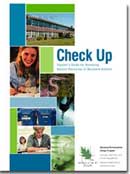
For Assessing Natural Resources in Maryland Schools
Grades 6-12
 Check Up is a teacher’s guide provided by the Environmental Design Program of the Maryland Department of Natural Resources. This teacher’s guide is designed for grades 6-12 and provides teachers with the information they need to identify and implement actions that are good for the environment and make economic sense. Students conduct natural resource assessments at their school and learn first hand how to better live in harmony with the natural environment by conserving energy and water, and reducing waste.
Check Up is a teacher’s guide provided by the Environmental Design Program of the Maryland Department of Natural Resources. This teacher’s guide is designed for grades 6-12 and provides teachers with the information they need to identify and implement actions that are good for the environment and make economic sense. Students conduct natural resource assessments at their school and learn first hand how to better live in harmony with the natural environment by conserving energy and water, and reducing waste.
Schools that participate in Check Up also have the unique opportunity to serve as models by demonstrating sound land use practices on site. In addition, Check Up participation can be applied toward the certification requirements for a Green School through the Maryland Association for Environmental and Outdoor Education.
Check Up in Practice
The Energy Check Up...
Teaches students to identify the ways that energy is used at their school, read and understand an electric meter and electric bill, and calculate the amount of energy used by and the cost of running specific appliances. Students then devise a plan to reduce energy consumption and calculate potential monetary and energy savings from their plan. Finally, students prepare a presentation to bring before their principal or school board to suggest implementing changes based on the savings.
The Water Check Up...
Teaches students to identify the ways that water is used at their school, read and understand a water meter and water bill, calculate the amount of water used by specific fixtures, and calculate the amount of water wasted by leaky fixtures. Students then devise a plan to reduce water waste, and calculate potential monetary and water savings from their plan. Finally, students prepare a presentation to bring before their principal or school board to suggest implementing changes based on the savings.
The Waste Check Up...
Teaches students to identify types of waste produced at their school and calculate the volume of waste produced each day, month and year. Students then devise a plan for waste reduction and calculate potential monetary savings from their plan. Finally, students prepare a presentation to bring before their principal or school board to suggest implementing changes based on the savings.